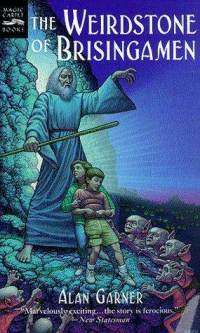The Weirdstone of Brisingamen

The Weirdstone of Brisingamen is a 1960 fantasy novel by English Alan Garner. Published originally by Collins, whose head at the time was looking for more fantasy novels in order to cash in on the success of The Lord of the Rings, The Weirdstone went on to critical and commercial success at the time and has remained popular ever since (though not so much with its author). There's even a musical adaptation made in the 70s, which was recently re-arranged by goth band Inkubus Sukkubus, though for copyright reasons their version is unlikely to ever see the light of day.
The story of Weirdstone draws heavily on the local folklore of Cheshire, specifically a folk tale called The Wizard Under The Hill which revolved around a wizard guarding a cave in which King Arthur and his knights slept. Garner also borrowed other elements from Norse and Celtic mythologies; the lios and svart-alfar, the Morrigan, Ragnarok and mixed them all together to create a story of his own.
Weirdstone starts out with a retelling of a local tale of the Wizard Under The Hill, who needed a white mare to complete his set of horses for the Sleepers. He buys one from a local farmer at market, and in the process, the farmer is taken to Fundindelve, the Cave of The Sleepers. Being an avaricious man, he steals away the Weirdstone from the cave, compromising the spells that keep the Sleepers from aging and dying. Centuries later, Susan and Colin, the child-protagonists, are sent to stay with grumpy farmer Gowther Mossock and during their explorations of nearby Alderly Edge, come to encounter the wizard, Cadellin Silverbrow, who is the guardian of the Cave of The Sleepers. Unbeknownst to either the children or the wizard, Susan is related to the farmer whom Cadellin purchased the horse from; the stolen Weirdstone became a family heirloom which Susan wears around her wrist in a bracelet. Cadellin fails to notice the bracelet, but its significance is not lost on the malevolent Selina Place and her Morthbrood, who seek to bring about the return of Nastrond, the Spirit of Darkness whom the Sleepers banished centuries ago and whose return they were enchanted to wait for.
- All Trolls Are Different: The Mara.
- Beneath the Earth: It's where the svart-alfar live. Latter portions of the book spend some time in old mine workings and svart caves.
- Big Bad: The Morrigan, aka Selina Place.
- Bigger Bad: Nastrond, the Spirit of Darkness.
- Cosmic Keystone: The titular Weirdstone of Brisingamen. It is what powers the enchantment that protects the chosen knights until they need to rise and fight Nastrond.
- Evil Smells Bad: The svart-alfar and Nastrond himself are both described as accompanied by a foul stench.
- Exposition of Immortality: Cadellin; when we first encounter him, is purchasing a horse from a farmer in the 17th century. When he's next encountered, unchanged, it's the 20th century.
- The Fair Folk
- Functional Magic: Weirdstone has several different uses of this; there's the Device Magic of the titular stone; which anyone can use, whether they're inherently magical or not and Cadellin and Selina use a more Ritual Magic and Theurgy-esque type.
- Gratuitous Latin as the Language of Magic: One of the earlier examples of Magic being Latin.
- Luke, I Am Your Father: Though it's not a revelation to themselves (rather than bystanders), at the end of the book it is revealed that Cadellin and Grimnir are brothers.
- Luke Nounverber: Cadellin Silverbrow, Angharad Golden-Hand.
- Mineral MacGuffin: The titular Weirdstone. It's a magical gemstone, set into a bracelet and it's vitally important to maintaining the spells that keep the Sleepers alive and ageless in Fundindelve.
- No Communities Were Harmed: Alderly Edge, Macclesfield, Mobberly are all real places in Cheshire. Most of the places mentioned in the book along the Edge; The Wizard's Well, Golden Stone, the Beacon and so on are also real. See here for more information.
- Our Elves Are Better: The Lios-Alfar.
- Our Goblins Are Wickeder: The Svart-Alfar, although the name actually means 'dark elves' (but the Norse version from whom they take their name are more like goblins).
- Ravens and Crows: Serve as spies to Selina Place, appropriately enough, since she is an Expy of the Morrigan. In Irish mythology, the Morrigan is an aspect of the Goddess Babd, specifically goddess of war, strife and sovereignty who generally appears in the form of a crow.
- Really 700 Years Old: Cadellin and Selina both date back to the original banishment / imprisonment of Nastrond, several hundred years before the time period the novel is set in.
- Voluntary Shapeshifting: Selina Place is also called Shape-shifter.